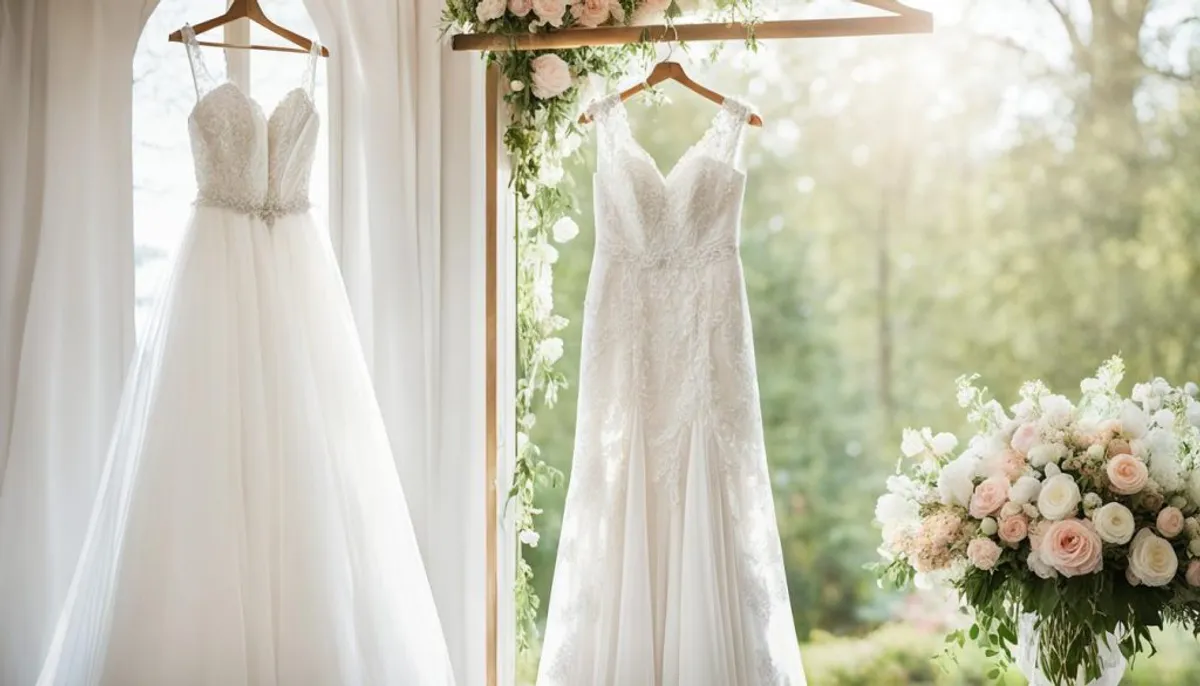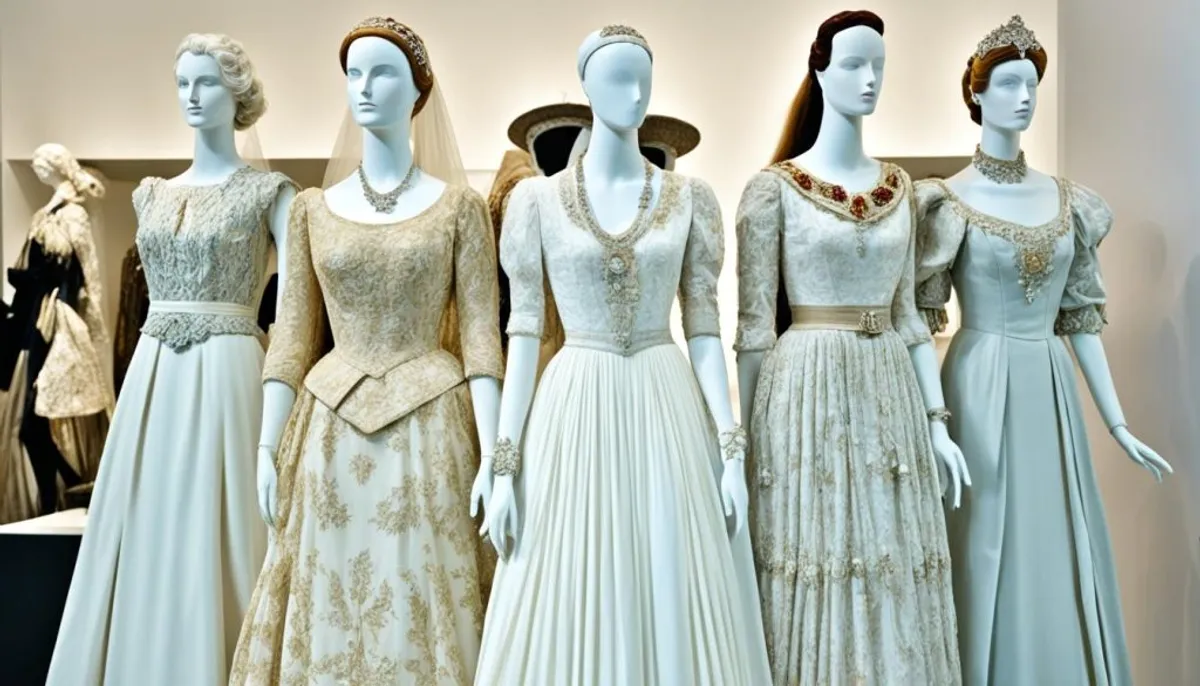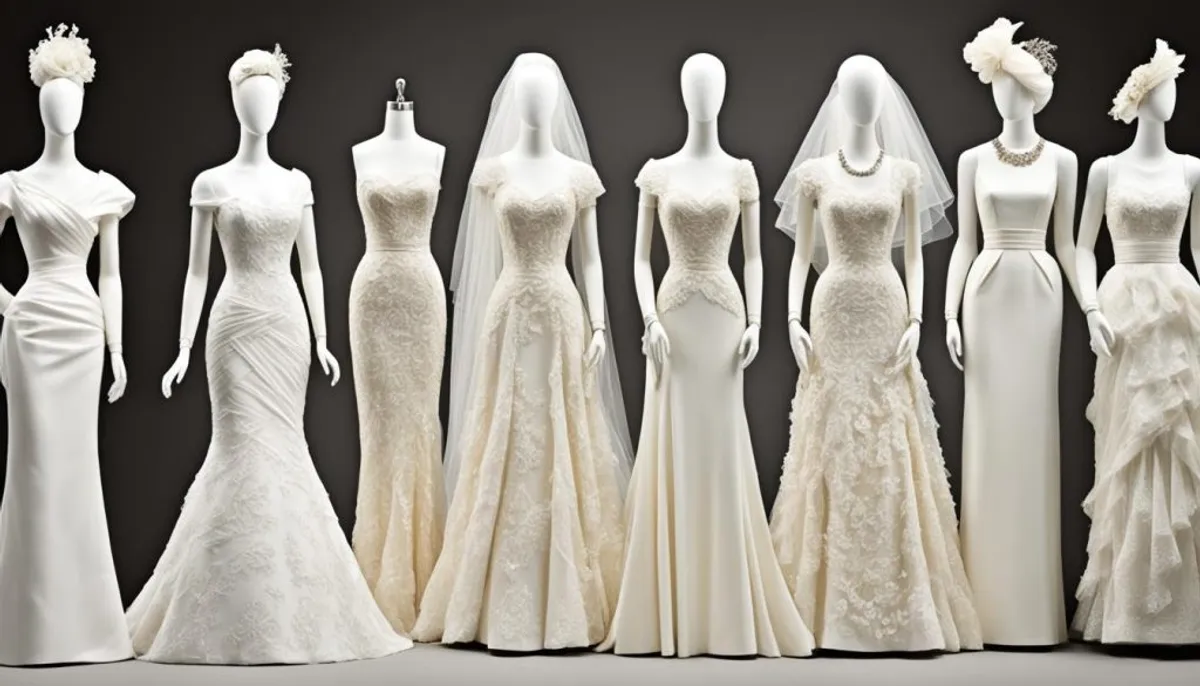The tradition of wearing white wedding dresses started in the Western world. Queen Victoria’s choice to wear a white lace dress at her 1840 wedding to Prince Albert was a big influence. Before then, brides wore many colors, including blue, yellow, black, and gray.
The white dress became a symbol of status. It showed the bride’s family could afford a fancy dress that could easily get stained. This made the white wedding dress a popular choice.
Over time, the white bridal gown spread to Europe and the United States. It became the top choice for brides in Western cultures. This tradition shows how a simple color choice can become a lasting symbol.

The White Wedding Tradition and Its Origins
The white wedding dress is a timeless symbol of purity, innocence, and new beginnings. It has deep cultural roots. The color white is linked with light, goodness, and religious commitment. In weddings, the white dress shows the bride’s high moral standing and the start of a new chapter.
The Symbolism of White in Weddings
White has been a symbol in weddings for centuries. Many cultures see white as a sign of purity, virtue, and sacred rituals. The white wedding dress symbolizes the bride’s virginity and her commitment to her time’s religious and social norms.
Queen Victoria’s Influence on White Wedding Dresses
Queen Victoria’s 1840 wedding made white wedding dresses popular. Before then, royal brides wore gowns in various colors. But Victoria’s white lace dress started a trend that spread across Europe and the Atlantic. The white dress became a symbol of wealth, showing the bride’s family could afford an elaborate, impractical gown.
The white wedding dress has evolved over time. It’s influenced by culture, religion, and society. From ancient symbolism to today’s meaning of purity and new beginnings, the white wedding dress remains important in bridal fashion history.
Historical Perspectives on Wedding Dress Colors
The color of wedding dresses has changed a lot over time. It shows us the history of bridal wear traditions. White is now the top choice for Western weddings, but it wasn’t always so.
Ancient Roman and Greek Wedding Dress Traditions
In ancient Rome, brides wore long veils of deep yellow. This color was seen as light and warmth. It was thought to keep evil spirits away and bring a happy marriage.
Also, in ancient Athens, brides wore violet or light reddish robes. The girdle was a key part of their outfit. These traditions show that white wasn’t always the go-to color for wedding dresses. Different cultures picked their own colors for marriage and growing up.
Ancient Chinese Bridal Wear Traditions
In ancient China, both brides and grooms wore sober black robes with red trim during the Zhou Dynasty. But, the Han Dynasty brought in seasonal colors. Green was for spring, and red for summer. These colors were thought to bring luck and match the seasons and life’s cycles.
These old bridal wear traditions show how important wedding dress colors were. They meant a lot to the couples and their communities.

The Cultural Significance of Bridal Fashion
Wedding dresses have always been more than just clothes. They mark a big change from being a child to being an adult, especially for women. The cultural meanings of white weddings and the symbolism of white dresses show how important the wedding dress is in the West and worldwide. Additionally, family approval in relationships plays a crucial role in the significance of these ceremonies, as it often reflects the values and traditions upheld by families.
In many cultures, the bride’s dress symbolizes death and rebirth. It shows the end of her old life and the start of a new one. Brides also aim to look like royalty, dressing to show they belong to a noble or elite class.
The dress’s cultural meanings have shaped how we see its importance. It marks big life changes and connects with power, status, and tradition. The bridal gown is a symbol that shows the deep cultural values and beliefs about marriage and being a woman.
Looking into bridal fashion’s cultural significance helps us value the traditions and beliefs that have shaped it. By understanding the dress’s symbolic meaning, we see its big impact on our views of love, commitment, and marriage’s changes.
The Evolution of Western Bridal Attire
The history of bridal fashion has seen big changes over the years. Before the 19th century, brides wore their best dress, not just white ones. Colors like black, brown, or gray were common. But, the white wedding dress became popular in the mid-19th century, thanks to Queen Victoria’s choice.
From Practical Dresses to Extravagant Gowns
As the white dress trend grew, it became a sign of wealth. Being able to afford a fancy, impractical dress showed the bride’s family was wealthy. Now, wedding dresses are more elaborate, with the evolution of wedding attire making them a key part of the celebration.
The history of bridal fashion shows how wedding dresses have changed. They went from being practical to being symbols of status and the importance of the day. This change has made the wedding dress a big part of the celebration, showing how society and culture have influenced wedding fashion over time, often blending two traditions.

why the wedding dress is white
The tradition of the white wedding dress is deeply rooted in the symbolic meaning of the color white. In Western culture, white is seen as a symbol of purity, innocence, and new beginnings. It represents the bride’s virginity and high religious commitment. It also symbolizes starting a new chapter in her life.
The Meaning and Symbolism Behind the White Color
White is often seen as the color of perfection. It’s closely linked to religious traditions and the clothes worn during them. Over time, the white dress became a status symbol. It showed the bride’s family was wealthy and had leisure, as the dress was impractical for work or everyday use.
The meaning and symbolism of white in weddings is more than just about the bride’s virtue. White is like a blank canvas. It lets the bride show her style and personality through the dress’s design.
| Symbolism of White in Weddings | Explanation |
|---|---|
| Purity | White is linked with cleanliness, innocence, and moral virtue. |
| New Beginnings | The white dress symbolizes the start of a new chapter in the bride’s life. |
| Wealth and Status | Wearing a white dress was a sign of the bride’s family’s affluence. |
The white wedding dress is a powerful symbol in Western culture. It represents the meaning and symbolism of the color white. It’s tied to the sacred rite of marriage.
Traditional Wedding Dress Colors Around the World
In Western cultures, the white wedding dress is common. To maintain the beauty of such dresses, a weekly ring cleaning routine is essential. But, in other parts of the world, brides wear different colors and styles. These choices reflect the deep cultural meanings of color and how bridal fashion varies across societies.
Chinese, Japanese, and Korean Bridal Wear Traditions
In China, brides wear red dresses to symbolize life, luck, and joy. Red is thought to keep evil spirits away and bring happiness to the couple. In Japan, brides change into different kimonos during the ceremony, each with its own special meaning.
In Korea, the bride wears a robe in red, green, and yellow. These colors stand for nature’s harmony and the universe’s balance. These beliefs are key in Korean culture.
| Country | Traditional Bridal Wear Colors | Symbolic Meaning |
|---|---|---|
| China | Red | Life, luck, celebration |
| Japan | Multiple colored kimonos | Symbolic meanings of each color |
| Korea | Red, green, yellow | Harmony of nature, balance of the universe |
These traditional wedding dress colors and bridal wear traditions highlight the rich cultural diversity in bridal fashion. They show us that there’s more to bridal fashion than just the white gown.
The Rise of the Modern Bridal Industry
The evolution of wedding attire and the history of bridal fashion changed a lot in the 20th century. This was thanks to the modern bridal industry growing. As couples began focusing on managing wedding expectations, middle-class people wanted more formal weddings, which led to the need for wedding planners.
Bride’s Magazine started in 1934, and Modern Bride came out in 1949. These magazines made the white wedding dress the standard for brides in the West. Movies from Hollywood also made this tradition popular after World War II.
The white wedding dress became popular because of the bridal industry’s influence. As formal weddings became more popular, wedding planners and bridal magazines helped make the white dress a must-have.
| Year | Event | Impact on Bridal Fashion |
|---|---|---|
| 1934 | First edition of Bride’s Magazine published | Solidified the white wedding dress as the norm |
| 1949 | Modern Bride magazine launched | Further homogenized the white wedding tradition |
| Post-WWII | Weddings portrayed in Hollywood movies | Helped crystallize the white wedding tradition |
The modern bridal industry made the white wedding dress very popular in the West. Specialized magazines and Hollywood movies helped make this tradition the norm for brides.
Conclusion
The white wedding dress has a deep history and symbolizes many things. It started with ancient traditions in Rome and Greece. Now, it’s a symbol of purity, new beginnings, and the start of marriage.
The story of why the wedding dress is white is tied to cultural meanings of white weddings. Yet, the dress has changed over time. It now reflects the growth of the bridal industry and the idea of the “perfect” wedding.
The white wedding dress goes beyond any single culture. It shows the deep meaning of marriage for both the couple and society. As couples in Saudi Arabia consider various aspects of their weddings, including dowry costs in saudi arabia, and globally say their vows, the white dress will keep its special place. It links today to the past.
RelatedRelated articles



